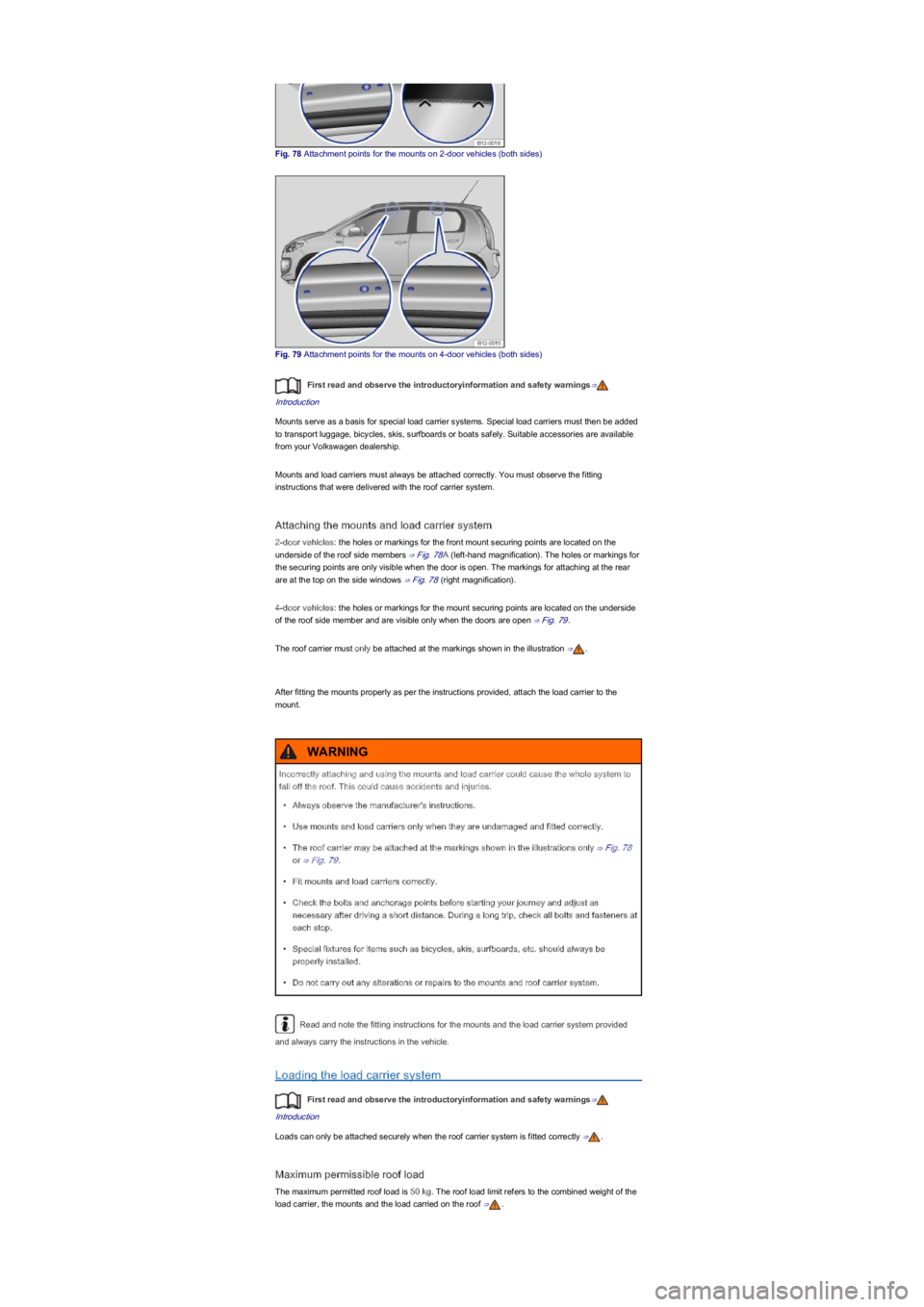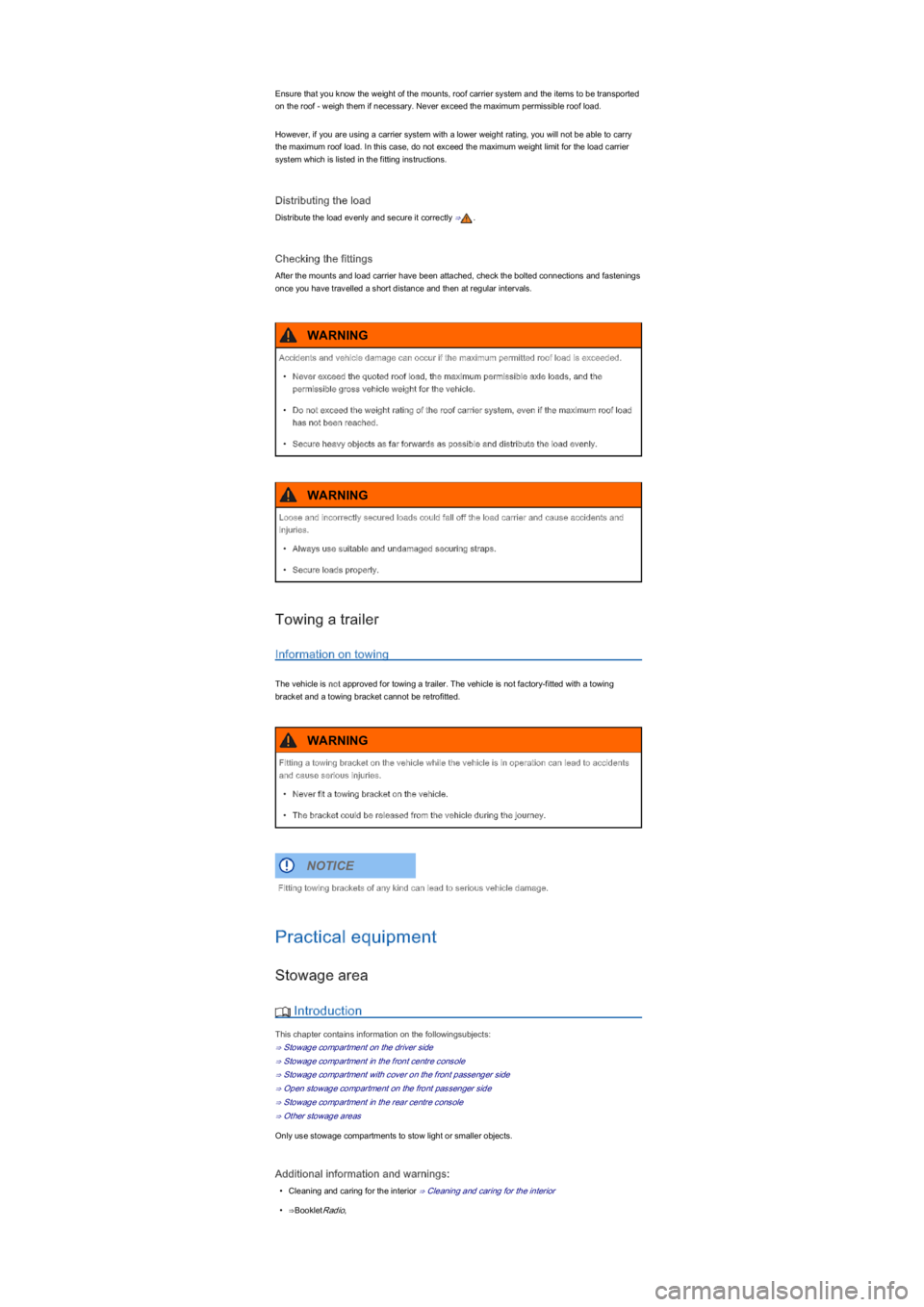Page 77 of 211
Roof carrier
Introduction
This chapter contains information on the followingsubjects:
⇒ Attaching the mounts and load carrier system
⇒ Loading the load carrier system
The roof of the vehicle has been designed for optimum aerodynamic effect. It is therefore no longer
possible to attach conventional roof carrier systems to a rain channel on the roof.
As the rain channels have been integrated into the roof for better aerodynamics, only mounts or
roof carriers approved by Volkswagen can be used.
When should the roof carrier be removed?
\f
Page 78 of 211

Fig. 78 Attachment points for the mounts on 2-door vehicles (both sidesyf
Fig. 79 Attachment points for the mounts on 4-door vehicles (both sidesyf
First read and observe the introductoryinformation and safety warnings⇒
Introduction
Mounts serve as a basis for special load carrier systems. Special load carriers must then be added
to transport luggage, bicycles, skis, surfboards or boats safely. Suitable accessories are available
from your Volkswagen dealership.
Mounts and load carriers must always be attached correctly. You must observe the fitting
instructions that were delivered with the roof carrier system.
Attaching the mounts and load carrier system
2-door vehicles: the holes or markings for the front mount securing points are located on the
underside of the roof side members ⇒ Fig. 78A (left-hand magnificationyf�����7�K�H���K�R�O�H�V���R�U���P�D�U�N�L�Q�J�V���I�R�U�
the securing points are only visible when the door is open. The markings for attaching at the rear
are at the top on the side windows ⇒ Fig. 78 (right magnificationyf�.
4-door vehicles: the holes or markings for the mount securing points are located on the underside
of the roof side member and are visible only when the doors are open ⇒ Fig. 79.
The roof carrier must only be attached at the markings shown in the illustration ⇒.
After fitting the mounts properly as per the instructions provided, attach the load carrier to the
mount.
Read and note the fitting instructions for the mounts and the load carrier system provided
and always carry the instructions in the vehicle.
Loading the load carrier system
First read and observe the introductoryinformation and safety warnings⇒
Introduction
Loads can only be attached securely when the roof carrier system is fitted correctly ⇒.
Maximum permissible roof load
The maximum permitted roof load is 50 kg. The roof load limit refers to the combined weight of the
load carrier, the mounts and the load carried on the roof ⇒.
Incorrectly attaching and using the mounts and load carrier could cause the whole system to
fall off the roof. This could cause accidents and injuries.
\f
Page 79 of 211

Ensure that you know the weight of the mounts, roof carrier system and the items to be transported
on the roof - weigh them if necessary. Never exceed the maximum permissible roof load.
However, if you are using a carrier system with a lower weight rating, you will not be able to carry
the maximum roof load. In this case, do not exceed the maximum weight limit for the load carrier
system which is listed in the fitting instructions.
Distributing the load
Distribute the load evenly and secure it correctly ⇒.
Checking the fittings
After the mounts and load carrier have been attached, check the bolted connections and fastenings
once you have travelled a short distance and then at regular intervals.
Towing a trailer
Information on towing
The vehicle is not approved for towing a trailer. The vehicle is not factory-fitted with a towing
bracket and a towing bracket cannot be retrofitted.
Practical equipment
Stowage area
Introduction
This chapter contains information on the followingsubjects:
⇒ Stowage compartment on the driver side
⇒ Stowage compartment in the front centre console
⇒ Stowage compartment with cover on the front passenger side
⇒ Open stowage compartment on the front passenger side
⇒ Stowage compartment in the rear centre console
⇒ Other stowage areas
Only use stowage compartments to stow light or smaller objects.
Additional information and warnings:
\f
Page 137 of 211

With the engine at operating temperature, park the vehicle on a level surface to ensure
that the engine oil reading is correct.
Switch off the engine and wait a few minutes for the engine oil to flow back into the sump.
Open the bonnet .
Identify the engine oil filler cap and oil dipstick. The engine oil filler opening bears the
symbol on the cap and the oil dipstick has a coloured handle. If you cannot find the cap
and dipstick please contact a qualified workshop.
Pull the dipstick out of the guide tube and wipe it off with a clean cloth.
Insert the oil dipstick into the guide tube again as far as it will go. If there is a marking on
the oil dipstick, this marking must fit in the corresponding groove at the top end of the
guide tube when inserting.
After reading the oil level, push the oil dipstick back into the guide tube as far as it will go.
Unscrew the engine oil filler opening cap .
Using only the engine oil approved by Volkswagen expressly for this engine, top up the oil
in small gradual amounts (no more than 0.5 lyf�.
To avoid overfilling, wait for approximately one minute after each pour to allow the engine
oil to flow into the oil sump up to the marking on the engine oil dipstick.
Read the engine oil level from the dipstick again before refilling with a further small
quantity of engine oil. Never overfill engine oil .
After the refilling procedure, the engine oil level should be at least in the centre of area Ⓑ,
but never above area Ⓐ .
After refilling, screw the engine oil filler cap back on correctly.
Reinsert the oil dipstick correctly into the guide tube as far as it will go.
Close the bonnet correctly .
Checklist
Carry out the steps in the specified order ⇒:
Pull the dipstick out again and read the engine oil level on the dipstick as follows: Ⓐ: do not
refill oil . Proceed to step 15. Ⓑ: oil can be refilled (approximately 0.5 lyf�����3�U�R�F�H�H�G���W�R���V�W�H�S�����
or 15. Ⓒ: oil must be refilled (approximately 1.0 lyf�����3�U�R�F�H�H�G���W�R���V�W�H�S�����.
The engine oil level must never be above area ⇒ Fig. 121Ⓐ. Otherwise oil can be drawn in
through the crankcase breather and escape into the atmosphere via the exhaust system.
Engine oil consumption
First read and observe the introductoryinformation and safety warnings⇒
Introduction
Engine oil consumption can vary from engine to engine and can change during the working life of
an engine.
Depending on how you drive and the conditions in which the car is used, oil consumption can be up
to 1.0 litre/2,000 km \f